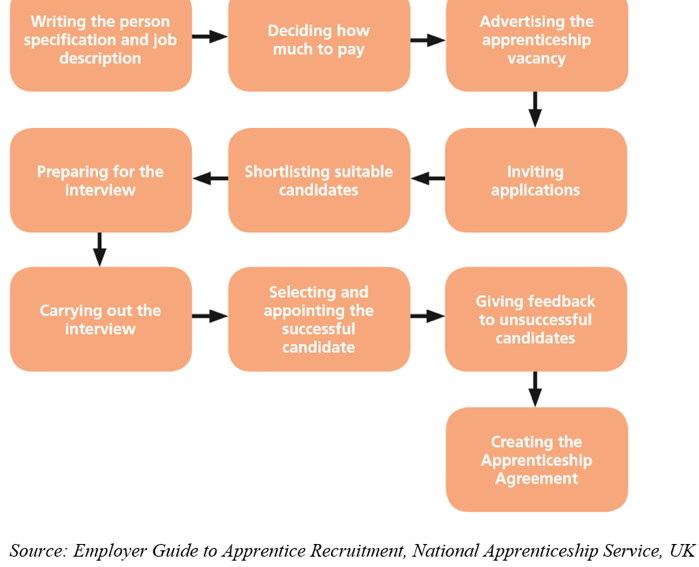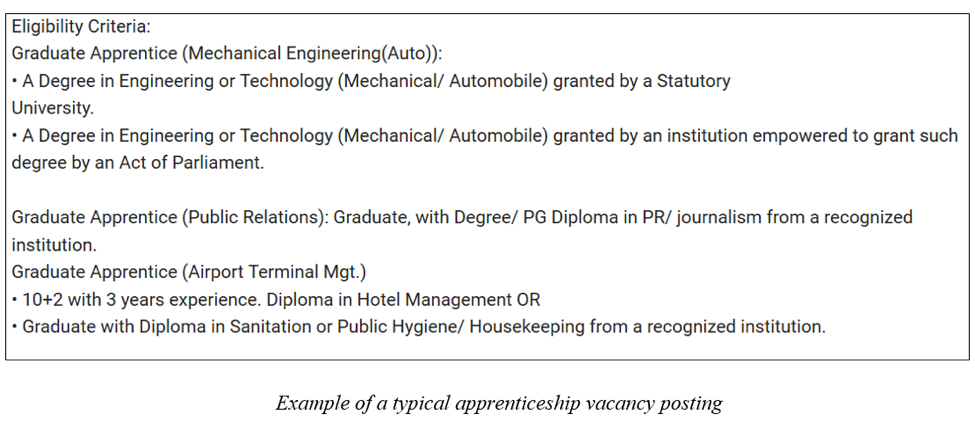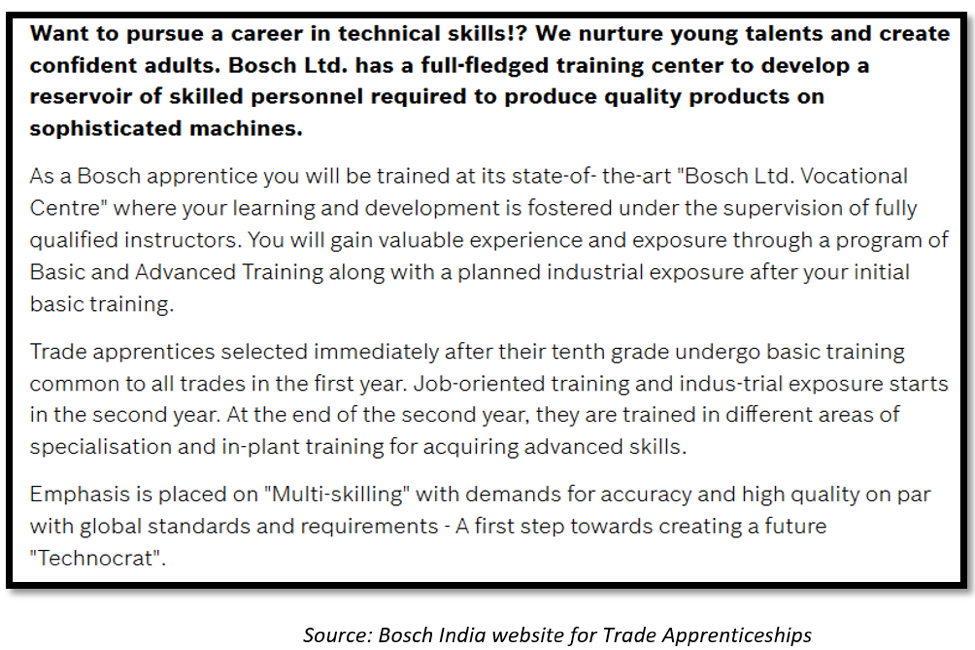“When done properly, apprenticeships are an excellent way to reach out to a wide talent pool and allow employers to grow their own, ensuring they have the future skills their organisation needs to succeed.”
Katerina Rüdiger, former Head of Skills and Policy Campaigns, Chartered Institute of Personnel and Development, UK
For companies new to the notion of apprenticeships, finding the right apprentice for your organisation can feel like a formidable task. In this post we examine a few key considerations in recruitment of apprentices. These recommendations can help both employers and training providers, on whom is placed the onus to provide clear information and adopt transparent recruitment practices to build credibility for apprenticeships as a valued route to skills-based training and gainful employment.
Starting Point
Hiring an apprentice is not much different to that of any other employee.


Much of the initial processes of registering interest, advertising vacancies, and going through the administrative steps have now been streamlined. The online portals for the two main schemes of apprenticeships in India- the National Apprenticeship Promotion Scheme (NAPS), and the National Apprenticeship Training Scheme (NATS) are full-service on-boarding platforms where employers can:
- Advertise apprenticeship vacancies
- Search & shortlist candidates specific to sector, trades, region etc.
- Issue offer letters
- Submit apprenticeship contracts
Nonetheless, the uptake of apprenticeships in the country continues to be abysmally low, at best around 3 lakh formal apprenticeships as against 71 lakh enterprises.[i] How can good recruitment practices help boost overall apprenticeship numbers?
The Skills Gap Issue
India is faced with a dual employment problem of hundreds of unemployed youth and hundreds of unfulfilled vacancies. Estimates suggest around 75 percent of youth entering the workforce are unemployable. Why is that?
According to Divya Jain, founder and CEO of Safeducate- a skilling and consulting firm, youth do not receive the crucial hand-holding in the initial stages of their job search.[ii] Educational institutes churn out graduates in the millions who are starkly not aware of what skills they need to become relevant to industry. This is where the value of an immersive real world work experience such as apprenticeships shines through. Employers increasingly seek candidates who have a combination of technical and soft skills. Getting the right apprentice begins with a fair, transparent and well defined recruitment process.
A report[iii] by the UK’s Chartered Institute of Personnel and Development sets key recommendations to support training providers and employers to establish good apprenticeship recruitment practices. We look at a few which make sense in the Indian context.
Raising the Profile
Apprenticeships are primarily targeted at youth. Young people should be encouraged to proactively seek out careers information advice and have the freedom to ask questions before and during an apprenticeship as part of a fair and transparent recruitment process.
Employers and training providers have a huge responsibility to raise the profile of apprenticeships for youth. Especially in the Indian scenario, where a traditional degree is considered far more prestigious than skills based or vocational education, a lot more needs to be done to attract young people to apprenticeships as a stepping stone to a successful career.
We feel one way to achieve this is for employers and training institutes to provide clear information about the financial benefits (the earn while you learn model for instance) and career prospects of apprenticeships at recruitment drives. A common misconception about apprenticeships is that they lead to low value jobs or ‘cheap labour’ for the less academically inclined. Hence, youth need to be made aware through an honest and clear transfer of information at the recruitment stage by highlighting the potential advantages of an apprenticeship. Yes, to start with apprenticeships tend to offer modest pay compared with other entry-level jobs. For example, monthly government stipend rates paid to the different categories of apprentices ranges from Rs. 2758 to Rs. 4984.[iv] However, employers are free to pay above this minimum wage range. Very interestingly, a TeamLease Servicesreport[v] comprising of three years’ worth of data from job portals and its own internal database found that the salary of a skilled blue collar worker across 12 sectors exceeded those of engineers anywhere between 10% and 27%.
TeamLease state that an advanced pattern maker earning Rs. 20,000 in 2015 can expect to reach Rs. 55,000 in eight years. And, an electrician in an electronics company was earning Rs. 54,900 after eight years of experience, 4% more than what an engineer in the same industry was earning with the same experience.v
Such encouraging and positive data on the potential of a higher wage premium and steady job prospects are key selling points of apprenticeships and can be used as significant motivators by employers in their recruitment processes to encourage youth to apply for apprenticeship roles. Candidates need a down the road longer term perspective of how apprenticeships can be a path to progress and higher salaries, and awareness building during recruitment drives is a crucial way to achieve that.
Tailor Made Vacancies
Just as a regular employee expects to benefit from their time with an employer (and vice versa) so does an apprentice. The more clearly defined a job description, relating to a specific industry or trade, the better the chances for an employer to attract the right kind of candidates. Ergo, the tone of recruitment should be ‘youth-friendly’ starting with the actual advert for the vacancy. We have observed that a typical apprenticeship vacancy advertised in online job portals tends to be lackadaisical and uninspiring.


It is of little surprise then that the profile of apprenticeships continues to be low in the absence of any clear description of the purpose of the job, background of the company and the sector, growth prospects or financial benefits; essentially there is very little to entice youth into considering apprenticeships as a sought after ‘hot job’ when they see such poorly structured adverts.
Conversely, a well thought out advert that speaks directly to youth becomes a much more attractive proposition whilst raising the credibility of apprenticeships at the same time.


Working with Training Institutes
If an employer is interested in hiring an apprentice, a key consideration is finding staff to be a mentor and the necessary infrastructure to deliver the apprenticeship. Smaller organisations may not have the resources to offer a full-fledged on premise on- -the-job training experience. That’s where training institutes come in and become an integral part of the recruitment process. With 2,204 government run and 12,108 privately run Industrial Training Institutes (ITIs) affiliated to the National Council of Vocational Training[vi], choosing and working with the right ITI is crucial to the success of recruiting the right apprentice.
Employers need to ensure that the ITI is right for their business to avoid the common pitfall of run-of-the-mill candidates which will otherwise continue to feed the vicious cycle of the job-skills mismatch conundrum.
Some considerations when selecting a training partner:
- Sectoral experience of the training provider
- Success rate of training apprentices leading to suitable employment
- Staff qualifications and experience
- Flexibility to customise training to meet employer business needs
- Training delivery model
- Processes for support and development of apprentices
- Value for money
Useful Guides for Employers
Good practice recruitment processes are crucial for boosting meaningful apprenticeships in the country.
We have put out other practical guides designed to help employers understand the basics of starting an apprenticeship program.
Read Part I of Getting an Apprenticeship Program Off the Ground – A Toolkit for Employers, and Part II, where we have delved into an employer’s obligations and responsibilities, financial assistance from the government, and how to embark on your apprenticeship journey.
References
[i] Scaling up apprenticeship schemes only way to boost formal employment, Feb 18 2019, Financial Express
[ii] On National Youth Day, know how India can close its massive skill gap and deal with unemployment, Jan 12 2019, India Today
[iii] The match factor – Good practice in apprenticeship recruitment- Chartered Institute of Personnel and Development, UK, October 2014
[iv] Directorate General of Training website, MoSDE
[v] When electricians earn more than engineers, Apr 2016, LiveMint
[vi] ITIs in India: Ministry Lists Number of ITIs, Steps to Improve Training Quality- Aug 6 2018, AglaSem News














